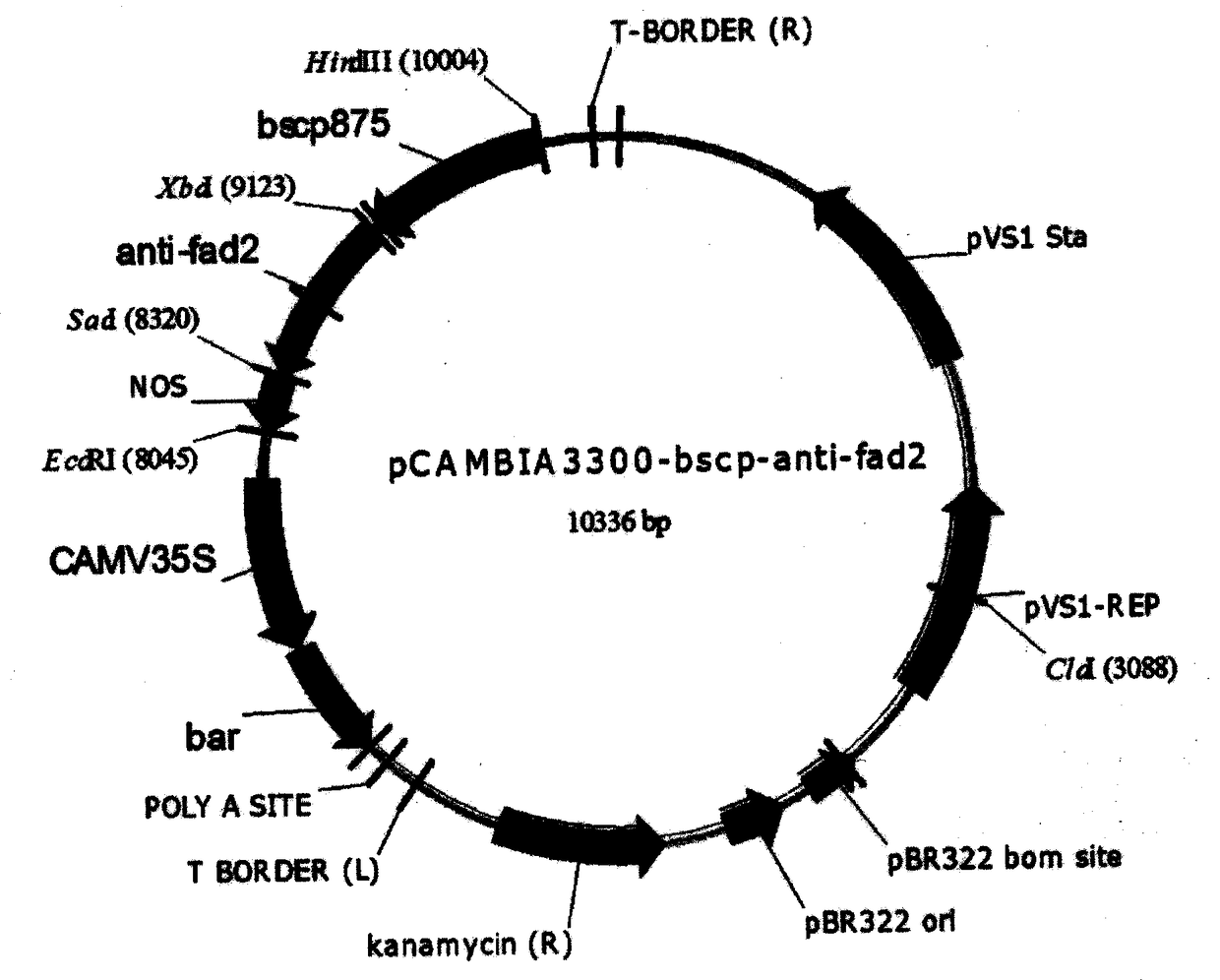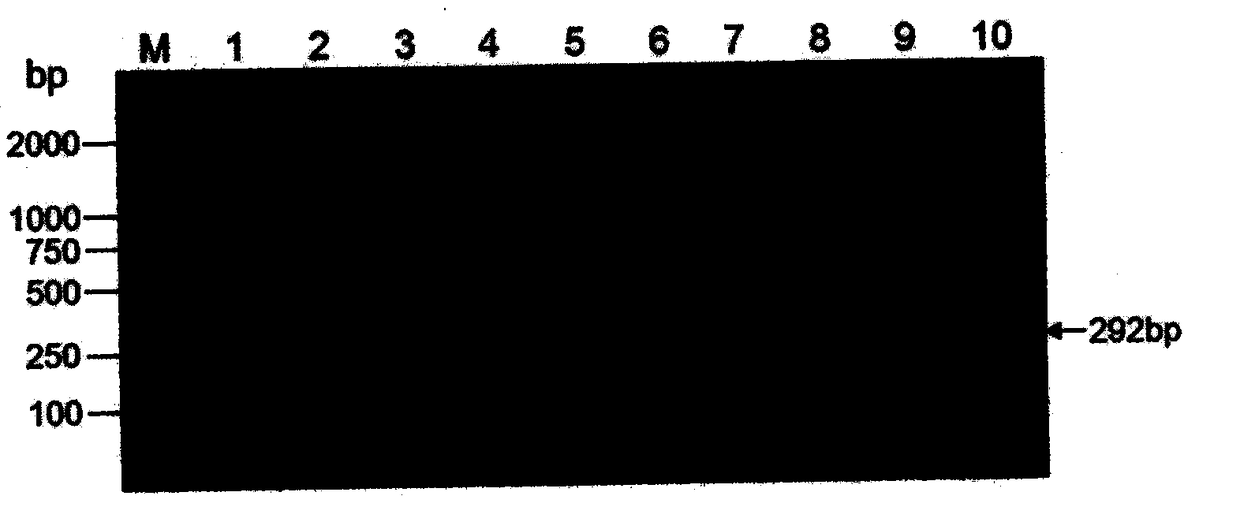Flanking sequences of exogenous insert of high-oleic-acid transgenic soybean event EB8072 and their application
A technology of EB8072 and transgenic soybeans, applied in the field of plant biology, can solve the problems of undiscovered EB8072 foreign insert fragment flanking sequence articles and patent reports, etc., and achieve the effect of effective supervision and management
- Summary
- Abstract
- Description
- Claims
- Application Information
AI Technical Summary
Problems solved by technology
Method used
Image
Examples
Embodiment 1
[0037] Example 1. Analysis of the insertion site of the exogenous fragment of the transgenic soybean event EB8072
[0038] 1. Genomic DNA extraction of transgenic soybean EB8072
[0039] (1) Genomic DNA extraction: Take 1-2 g of young soybean leaves, grind them into powder with liquid nitrogen, and put them into a 50 mL centrifuge tube. Add 5mL extract solution A (100mmol / L Tris-HCl, pH8.0, 0.35mol / L sorbitol, 5mmol / L EDTA, pH8.0, 1% 2-mercaptoethanol), 3.5mL extract solution B (50mmol / L L Tris-HCl, pH8.0, 4.0mol / LNaCl, 1.8% CTAB, 25mmol / L EDTA, pH8.0), 0.3mL 30% sodium lauroyl sarcosinate and 2% PVP-360, incubated at 55°C 60-90 minutes, shaking gently several times during the period. Take out the centrifuge tube, add an equal volume of chloroform:isoamyl alcohol (24:1), shake it upside down for 15 minutes, and then centrifuge at room temperature for 10 minutes (13000rpm). Aspirate the supernatant, add 2 / 3 volume of pre-cooled isopropanol mixed with 1 / 10 volume of supernata...
Embodiment 2
[0044] Example 2. Analysis of the flanking sequences of the left and right borders of the exogenous insert in transgenic soybean event EB8072
[0045] PCR detection primers were designed according to the sequence of the exogenous insertion fragment of the transgenic soybean event EB8072 and the upstream and downstream sequences of the insertion site in the soybean reference genome. The primers for the upstream sequence amplification of the EB8072 insertion site are EB8072LB-F1 (5'-ACCACCATTATTAGAGCCTTGAGG-3') and EB8072LB-R1 (5'-TTCCACACAACATACGAGCCG-3'); the downstream sequence amplification primers for the EB8072 insertion site are EB8072RB-F1 ( 5'-ACGTGGGTTTCTGGCAGCTGG-3') and EB8072RB-R1 (5'-GCCTAAGGGTAAAGGGATTTGAGTAG-3').
[0046] Using EB8072 genomic DNA as a template, the above primers were used for PCR amplification. The PCR reaction system (25uL) is: 10×PCR buffer 2.5uL, 10mmol / L dNTPs 0.5uL, 5U / uL Taq enzyme 0.5uL, sample DNA 1.0uL, 10umol / L forward primer 0.5uL, 10...
Embodiment 3
[0048] Example 3. Specific PCR detection of transgenic soybean event EB8072
[0049] According to the flanking sequence of the left border (as shown in SEQ-2) and the flanking sequence of the right border (as shown in SEQ-3) of the exogenous insert fragment of the transgenic soybean event EB8072, specific detection primers were designed respectively. In the left border flanking sequence-specific detection primer combination, one of the primers is a forward primer designed according to the sequence of the first 1-500 positions of SEQ-2, as shown in SEQ-4; the other primer is based on the 501- The reverse primer designed for the sequence at position 1046 is shown in SEQ-5. In the right border flanking sequence-specific detection primer combination, one of the primers is a forward primer designed based on the sequence of the 1-422 positions of SEQ-3, as shown in SEQ-6; the other primer is based on the 423- The reverse primer designed for the 1022 site sequence is shown in SEQ-7....
PUM
 Login to View More
Login to View More Abstract
Description
Claims
Application Information
 Login to View More
Login to View More - R&D
- Intellectual Property
- Life Sciences
- Materials
- Tech Scout
- Unparalleled Data Quality
- Higher Quality Content
- 60% Fewer Hallucinations
Browse by: Latest US Patents, China's latest patents, Technical Efficacy Thesaurus, Application Domain, Technology Topic, Popular Technical Reports.
© 2025 PatSnap. All rights reserved.Legal|Privacy policy|Modern Slavery Act Transparency Statement|Sitemap|About US| Contact US: help@patsnap.com



